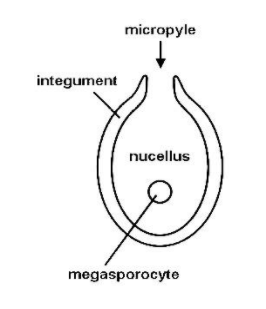
In pinus ovule the number of integuments is
(a)1
(b)2
(c)3
(d)4
Answer
571.8k+ views
Hint: The ovule is an integument megasporangium within which the meiosis and megaspore formation takes place. Integuments are outer coverings of ovules that provide protection to the developing embryo.
Complete answer:
Pinus is a gymnosperm and generally has one integument (unitegmic) however angiosperms typically have two integuments (bitegmic).
Additional Information: The evolutionary birth of the inner integument (which is integral to the formation of ovules from megasporangia which occurs inside the nucellus of developing ovules of angiosperms) has been proposed to be an enclosure of a megasporangium by sterile branches. Chalaza is the place of origin of the integuments or the basal swollen part of the nucellus. The nucleus is a mass of parenchymatous tissue surrounded by integuments. It encloses the embryo sac and provides nourishment to the developing embryo. The Micropyle is a small opening for the entry of the pollen tube into the ovule. The micropyle allows the passage of pollen grain(male gametophyte) into the ovule by a narrow opening into the embryo sac. The integuments of ovule are transformed into seed coats. In gymnosperms(non-flowering plants) (e.g., conifers, pinus), the pollen(male gametophyte) is drawn into the ovule on a drop of fluid that exudes out of the micropyle, the so-called pollination drop mechanism. The pollination drop is a liquid secretion produced by the ovule and exposed outside the micropyle for the entry of the pollen tube into the embryo sac. In many gymnosperms, pollen(male gametophyte) lands on the plane of the pollination drop, remoistens, and enters the ovule(female gametophyte) as the drop retracts.
So the correct answer is ’1’ i.e. is unitegmic.
Note: Integuments also have another zoological usage i.e. they form the layers of connective tissue, endoderm, mesoderm, and ectoderm. They form the integumentary system in some arthropods.

Complete answer:
Pinus is a gymnosperm and generally has one integument (unitegmic) however angiosperms typically have two integuments (bitegmic).
Additional Information: The evolutionary birth of the inner integument (which is integral to the formation of ovules from megasporangia which occurs inside the nucellus of developing ovules of angiosperms) has been proposed to be an enclosure of a megasporangium by sterile branches. Chalaza is the place of origin of the integuments or the basal swollen part of the nucellus. The nucleus is a mass of parenchymatous tissue surrounded by integuments. It encloses the embryo sac and provides nourishment to the developing embryo. The Micropyle is a small opening for the entry of the pollen tube into the ovule. The micropyle allows the passage of pollen grain(male gametophyte) into the ovule by a narrow opening into the embryo sac. The integuments of ovule are transformed into seed coats. In gymnosperms(non-flowering plants) (e.g., conifers, pinus), the pollen(male gametophyte) is drawn into the ovule on a drop of fluid that exudes out of the micropyle, the so-called pollination drop mechanism. The pollination drop is a liquid secretion produced by the ovule and exposed outside the micropyle for the entry of the pollen tube into the embryo sac. In many gymnosperms, pollen(male gametophyte) lands on the plane of the pollination drop, remoistens, and enters the ovule(female gametophyte) as the drop retracts.
So the correct answer is ’1’ i.e. is unitegmic.
Note: Integuments also have another zoological usage i.e. they form the layers of connective tissue, endoderm, mesoderm, and ectoderm. They form the integumentary system in some arthropods.

Recently Updated Pages
Master Class 11 Economics: Engaging Questions & Answers for Success

Master Class 11 English: Engaging Questions & Answers for Success

Master Class 11 Social Science: Engaging Questions & Answers for Success

Master Class 11 Biology: Engaging Questions & Answers for Success

Class 11 Question and Answer - Your Ultimate Solutions Guide

Master Class 11 Business Studies: Engaging Questions & Answers for Success

Trending doubts
10 examples of friction in our daily life

One Metric ton is equal to kg A 10000 B 1000 C 100 class 11 physics CBSE

Difference Between Prokaryotic Cells and Eukaryotic Cells

1 Quintal is equal to a 110 kg b 10 kg c 100kg d 1000 class 11 physics CBSE

Explain zero factorial class 11 maths CBSE

What is a periderm How does periderm formation take class 11 biology CBSE




